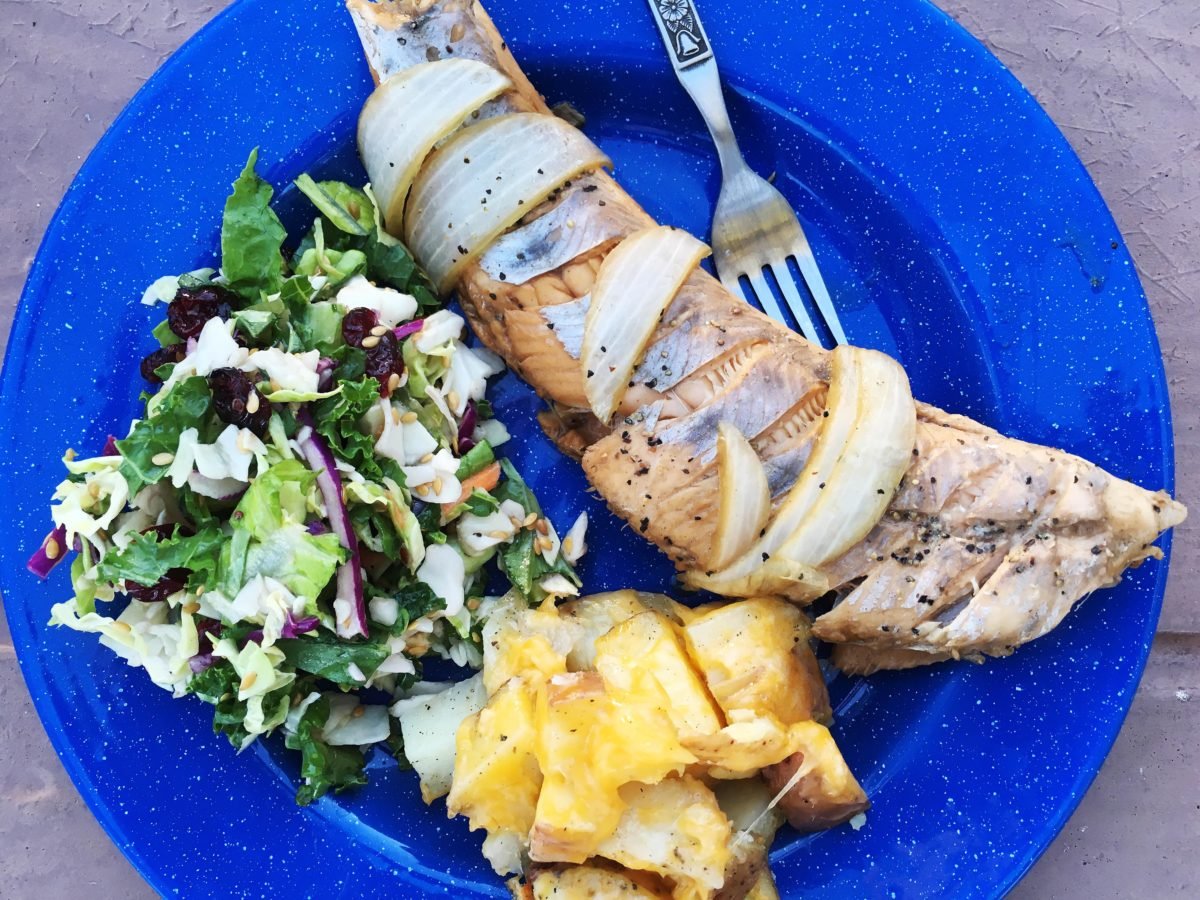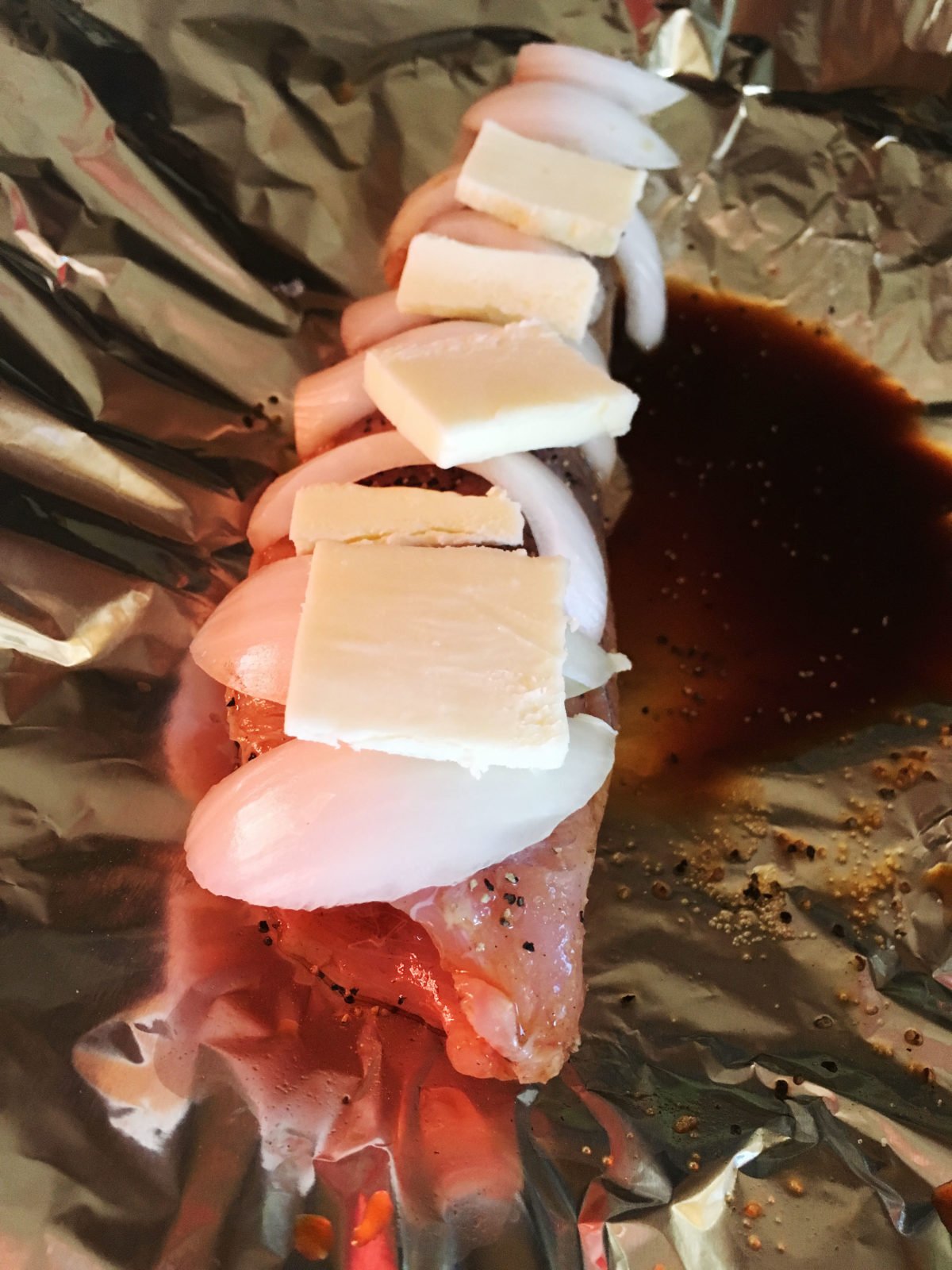Easy to prepare but sensational tasting, this salmon burger whips up incredibly quick and is packed with spicy wasabi and hearty salmon!
Foil Wrapped Trout Packs
I am a planner. I like to know what lies ahead and how I am going to get there. I employ this attitude in almost everything I do in life. Stepping outside the plan is difficult for me, especially if I am not prepared for stepping outside the plan (somehow that doesn't even make sense, but if you are planner then you know what I am talking about!).
“The only real stumbling block is fear of failure. In cooking you've got to have a what-the-hell attitude.” ~ Julia Child
Camping is a planner's dream, or nightmare depending on how you look at it. I make lots of lists, trying to think of the unexpected popping up and how I will be prepared to tackle it. I try to cover everything I would could possibly need. Everything is broken down into lists, which have sub-lists, and then the lists are checked through, usually twice. For cooking, there is the master list of each meal: breakfast, lunch, dinner, dessert, and snacks. Then each meal is broken into two sub-lists: ingredients and tools. And then there is another list entirely for stocked items that I try to take everywhere. Things like cutting boards, knives that actually cut things (as opposed to most camping knives that tend to just tear things! I hate that!), extra bowls for mixing and such, spatulas, aluminum foil and Ziploc bags. The list is an ever evolving task that is added to each time a new hunting or camping trip happens.
With all that said, this past camping trip presented an unexpected. I never plan on catching fish. I consider myself a bad luck fisherman actually. Everyone around me can be reeling them in, and I will sit idly watching happy faces pull in beautiful fish. I would say it makes me sad, or jealous, or angry, or something, but I actually am used to it by now. So, you can imagine my surprise when this past weekend I limited out on rainbow trout two days in a row.
Since I never plan on catching fish, I never plan on cooking fish while at camp. This time was different. As I was cleaning the trout, I had this overwhelming urge to have fresh lake caught fish that night. I didn't know how it was going to happen, or if I had anything to prepare the fish with, but I knew it needed to happen. I needed to ditch the planned dinner and make a fish dinner.
Since supplies were limited, I decided to try and cook this fish in foil packets in the actual fire pit. I have done other meals this way before, usually ones filled with meat, potatoes, vegetables, and a gravy base. It is a quick way to make a fantastic tasting meal. It requires little preparation, little clean-up, and amazing results. I had never done fish this way before though.
Besides having no set way to cook this fish, I also had no recipe. So, this impromptu meal was going to have to be a "clean out the cupboard" type effort. I searched through bins for whatever spices and ingredients I could find. This recipe is what I came up with, and I have to say it was superb. I felt like I was eating at a five-star restaurant.
To start, you have to build a fire. This is usually a given at a campsite, but I thought I better mention it. If you aren't much a fire chef, which I can't say that I am one, you can also heat up some coals and just place the packets on top of the coals. I used my charcoal chimney for my dutch oven to heat up about ten coals and cooked over those. It worked great.
For this recipe, I left the fish on the bones. It makes for each fish cleaning, cooking, and the meat literally flakes off the bones once it is finished cooking.
To start, cut two pieces of aluminum foil about twice the size of fish. There needs to be enough foil to fold over the entire fish and other ingredients and then wrap the edges closed. The fish should be centered in the piece of foil with at least an inch of room around it. You want to use two pieces of foil to create a really good barrier between the heat of the fire and the fish. I have single layered the aluminum foil before and things tend to burn rather than steam.
Salt and pepper the fish. If you have some lemon pepper, which is a common seasoning used for fish, that would be great. You could also do my go-to favorite, Montreal Steak Seasoning. I put that on everything because I appreciate the balance of salt and pepper it has. Once the fish is seasoned, add thin slices of onion. Since this is an impromptu menu item, you might not have onions. You could also do minced garlic. Even dried onions or garlic would work, which is something many people leave stocked in their camping supplies. I tend to always take onions with me when camping because they can be added to many different dishes.
On top of the onion, places thin pats of butter. My slices were cut about a 1/16 of an inch thick. You could cut the pats thicker and just not place as many on top of the fish too. I ended up with about five mirco-thinly sliced pieces per fish. It was a good amount of butter. Oh, just a quick note. The butter I had was unsalted. If you used salted butter remember to not add more salt to packet or you could end up with a very salty dish.
Gently pour a good drizzle of Worcestershire sauce over the fish. It is okay if it just pools up below the fish. Once sealed, the packet will steam everything and the sauce will infiltrate the fish beautifully!
To create the packet, fold the foil over the top of the fish. Gently start rolling the edges of the foil towards the fish, taking care not to puncture or rip the foil. The foil has to be completely sealed or the juices will run out and things won't cook right. If you tear a whole, grab another piece of foil and add another layer to the packet. The best way to think about making packets is to just try and keep things pretty. The prettier the packet, the better things seem to hold together.
Cook the fish about five to seven minutes per side. This will ensure the fish is flaky and pink, the onions are soft and sweet, and the butter and Worcestershire have melted into a delicate sauce. When I was cooking, the packets actually puffed up when they were finished, which was also a good indicator that things were done. However, if there are any leaks in the packets, this won't happen so I would keep an eye on the timer.
For a quick side dish, I cooked up some cheesy dutch oven potatoes. Cube the potatoes into bite size pieces, season with salt and pepper (or as I did, because like I said I am crazy, you can add Montreal Steak Seasoning. I have a problem.), and cover with cheese. You could also throw in some onion if you have left-overs from the fish packets. Cook over coals, about ten to twelve on the bottom and eight to ten on the top, for twenty to thirty minutes, or until the potatoes are soft.
Happy Hunting!

Foil Wrapped Trout Packets
Ingredients
- 4 full trout, skinned and on the bone
- 1 onion, cut into thin slices
- salt and pepper
- 1/4 stick butter
- 4 tablespoons Worcestershire sauce
Instructions
- Light your campfire or charcoal coals.
- For each fish, cut two pieces of aluminum foil. Foil should be twice the size of the fish.
- Place fish in center of foil.
- Salt and pepper each fish.
- Place slices of onion along the fish.
- Cut butter into thin slices and lay atop the onion.
- Pour a tablespoon of Worcestershire over fish. Repeat with other three fish.
- Cook packets over the fire or coals and cook for five to seven minutes per side, flipping half way through the cook time, until fish are flakey and red. Onions should be soft and sweet. Enjoy!
Serrano Margarita Oyster Shots
Oysters. They’re a lot. They’re not for everyone. But I think this recipe for a serrano margarita oyster shot definitely helps make oyster eating a little easier on everyone.
Not growing up near a coastline definitely made oysters seem like a completely foreign food item. The only time I saw oysters growing up was the oblong shaped cans of smoked oysters on the tuna shelf in the supermarket. I never ate them. Just saw them.
The first time I tried an oyster was at a Chinese buffet off the highway in Delaware. I definitely made it into a big deal. It was very dramatic. I needed the other restaurant patrons to hear how this was my very first oyster, and how skeptical I was about eating it. It was a lot like when young children try a food for the first time and need everyone to know the importance of the monumental occasion.
After filling my buffet plate with chilled crab pieces and shrimp cocktail, I took a single shucked oyster from its icy bed and placed it almost ceremoniously in the center of the plate. Back at the table, I picked the lone oyster from the plate, clinked it with a quick “cheers” with friends, and attempted to slurp it down.
In the movies, everyone always looks good eating an oyster. It’s almost equivalent to how people make smoking look cool in movies. They take a long, slow drag from their cigarette, roll the smoke around in their mouth, close their eyes in a small moment of bliss, and puff out beautiful smoke rings. Watch people smoke in real life and there is a lot of coughing and smoke kind of billows randomly about. Oyster eating is just like this.
In the movies, oysters are picked up delicately with the thumb and a single finger and then effortlessly, and more importantly cleanly, and quickly slurped, and mind you it is a soundless slurp, from their shell. They disappear quickly with a small swallow and then are followed by that closed eye small moment of bliss.
Real life oyster eating, especially the first time, is not at all like that. First, figuring out how to hold the oyster is a challenge. Every grip feels awkward. Do you clutch it? Do you palm it like a ball? Cradle it? And how do you keep your fingers out of the way of the meat?
After you get your grip, it’s time to slurp. It’s loud. And it’s actually a little embarrassing. Getting the meat out of the shell isn’t as easy as it looks. So you slurp harder and louder. All the liquid usually comes out first, and you choke on that a bit, and then the meat will break loose suddenly. It’s kind of like when you are trying to get the last bit of an icy drink from the bottom of a cup. You shake the cup a few times and eventually the entire block of ice breaks loose and unexpectedly falls all over your face.
My first oyster eating experience was very textbook. I couldn’t find my grip on the shell, and once I did the rest of was loud, a little embarrassing, and awkward. Things only got worse from there. Once I finally got the oyster out of the shell and started swallowing things went from bad to worse. The oyster hit the back of my throat and the texture was just all wrong.
All I could think about was how big, and gooey, and flat-out booger-esque the whole experience was. My mind kept thinking: “Just get it over with. Swallow faster.” Swallowing faster didn’t help. The foreign blob started working its way back up.
So the entire swallowing ordeal started all over. There was more gulping, a little bit of gasping, possibly some swearing. And it finally went down.
It took years for me to eat an oyster again. My second experience corrected all the mistakes I had made with my first oyster and I actually started to even like them a little bit. I learned you have to make sure the oyster meat is completely separated from the shell. Even the littlest section still attached makes that slurping part much more difficult. Second, the mignonette is everything. Don’t go dry oyster. Spice it up. You can make a single oyster into a complete and full flavor experience with the right mignonette. And it’s delicious! Finally, be brave and confident. Slurp like you’ve been slurping oysters all your life!
So, now that I feel like an accomplished oyster shooter, I am ready to share with you some of my favorite mignonettes. Today I am going to start with a serrano margarita themed oyster shot. This mignonette is spicy, tangy, and has a little kick from the tequila.
There isn’t really much to making the mignonette. In a small bowl, add about a tablespoon of finely minced shallot, a finely diced up serrano pepper, a shot of good tequila, a tablespoon of champagne vinegar, and ¾ cup of lime juice. Zest in some of the lime to get that pinch of freshness.
If you aren’t much for the heat, remove the seeds from the serrano before dicing it up. If you are someone who LOVES the heat, leave the seeds in.
I had to play around a bit with the ratio for the tequila and lime juice. So after adding my initial shot of tequila I drizzled in a bit more until it cut the tartness of the lime to a level of my liking.
This recipe makes a lot of mignonette. You could easily serve it on a dozen or even two dozen oysters. You should properly shuck the oysters and rest them on ice before serving. Here is a great video for properly shucking oysters: Oyster Shucking by America’s Test Kitchen.
Well, Happy Oyster Eating!
Manila Clam Pasta on the Grill
Manila clams are actually an imposter to the Washington ocean ecosystem. They are native to Japan and were accidentally introduced to the salty seas of the Washington coast line in oyster shipments. They can be found all along the Pacific coast line of the United States, and are actually a welcome addition to the waters because they are delicious! The clams are identified by their oval shaped shells with heavy ridge lines running the horizontal length of the shell.













